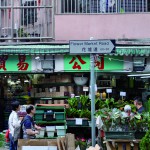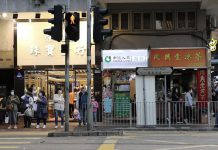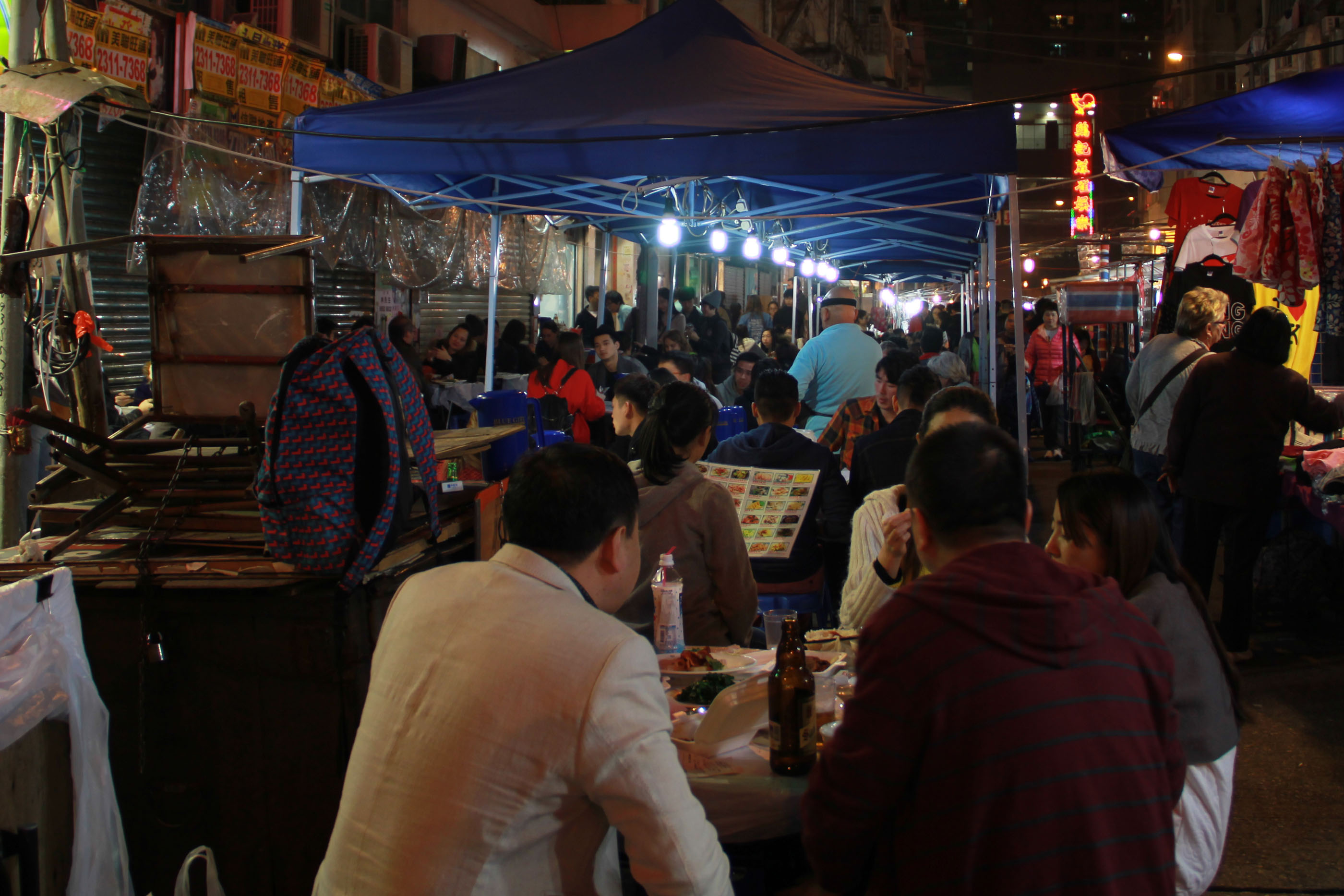Government proposes tightened laws against street obstruction but defenders urge for better use of the largest public spaces
By Cindy Gu & Karin Li
On most streets in urban Hong Kong, the pavements are filled with pedestrians and the roads filled with cars and trucks. But walking through Mong Kok’s Flower Market, the vehicles and pedestrians have to give way to pots containing lush green foliage and buckets of exotic blooms. The Flower Market is one of Hong Kong’s colourful feature shopping areas, it is also a street obstruction black spot.
It has long been common for shops in the Flower Market to put plants and flowers out on the sidewalk, or even in the road.
Ms Wong, who has been running her shop, New World Flower Corporation, on the periphery of the Flower Market on Fa Yuen Street, for 26 years says she only does so during certain times such as Lunar New Year or when she has a particularly big order and there is not enough room in the shop to accommodate the large baskets of flowers. Still, Ms Wong, who did not want to give her full name, was fined three times for street obstruction last year.
Defenders say the flower vendors should be treated leniently because the market is a unique Hong Kong landmark. “The Flower Market is a feature spot. It should be given immunity to put some flowers outside. Or else it will be an ordinary street just like every street in Mong Kok,” says Ko Shing-kon, the owner of a home accessories shop in the Flower Market.
The government disagrees. In a consultation document on Enhanced Measures Against Shop Front Extensions (SFEs), it said unauthorised shop extensions are “often at the expense of road access, safety and environmental hygiene, and affect the quality of city life. They usually cause nuisance, inconvenience and hazards to pedestrians and traffic.”

For authorities, shop extensions are a persistent problem in the Flower Market. According to the Food and Environmental Hygiene Department (FEHD), there were 149 related complaints and 343 prosecutions in the area in 2014.
Currently, businesses can receive a summons for violating a number of different laws such as “Obstruction of Public Places” under section 4A of the Summary Offences Ordinance, “Conduct of Food Business outside Licensed Food Premises” under section 34C of the Food Business Regulation, and “Illegal Hawkering” under section 83B of the Public Health and Municipal Services Ordinance. These are implemented by different departments including the FEHD and the police.
Typically, it can take around two months from a summons to prosecution in court and the average fine for the most common offences was just HK$ 595 in 2013.
To address the shortcomings of the existing system, namely, the long lead-time of prosecution, light penalties and the lack of a “targeted legal tool against SFEs”, the government’s consultation document suggests introducing an additional fixed, on-the-spot penalty of HK$ 1,500. The consultation period ended in July last year and the Home Affairs Department expects to submit a draft of the new law to the Legislative Council by October at the earliest.
Besides flower shops, al fresco dining is another common example of street obstruction. There were 49 related complaints and six prosecutions in Yau Ma Tei alone last year.
Temple Street in Yau Ma Tei is well known for its dai pai dong restaurants, which are a traditional part of Hong Kong’s dining culture.
Hing Kee, an old-brand restaurant on Temple Street renowned for its claypot rice (煲仔飯), used to extend its seating area to almost half the street. But such scenes have disappeared recently. The dining tables in the street have been replaced by several rows of chairs for diners waiting outside for a vacant table inside the restaurant. When Varsity phoned the owner for more details, she said she had cleared away the outdoor seating because she did not want to risk going to jail, and was reluctant to say more.
The problem for these eateries is that they are not licensed for outdoor business. Mr Wong, who is in his 50s and also prefers not give his full name, is the owner of another popular restaurant with over 20 years history on Temple Street. He is cautious when using outdoor spaces. Only a few tables spring up in front of his restaurant after 9 p.m. when FEHD officers are off duty.
According to the Food Business Regulation, those running restaurants outside the confines of their premises can face up to a HK$ 10,000 fine and three months in jail. Wong has already received the maximum fine several times.
In fact, food premises can apply to the FEHD for outdoor seating permission but applications are then referred to at least six other government departments. The applicant has to get the consent of all the departments and Wong thinks this is extremely difficult to achieve.
He says he will probably not put tables outside if the fixed penalty system is introduced, because “profits won’t offset the fine”. He worries that a streamlined on-the-spot penalty system would mean enforcement officers could take action against a business several times a day.
Although nearby residents may find outdoor dining a nuisance, many diners enjoy the ambience of outdoor dining, especially in the winter when claypot rice is most popular. “They like dining outside when the weather is cool in winter. They can enjoy street scenery at the same time. It feels so good,” Wong says.
Customers who prefer sitting outdoors include visitors who seek out dai pai dongs to experience the unique setting. Briton Lorraine Simpson, who works for British Airways, visits Hong Kong once a month. During her short stays in Hong Kong, she always dines with her friends at dai pai dongs here. “This is what we hope for. This is what we want,” she says, “you mustn’t lose it.”
According to Starry Lee Wai-king, the chair of the Panel on Home Affairs in LegCo, the main aim of a fixed penalty system is to act as a deterrent to street obstruction rather than to eliminate streets with distinctive local features. The panel is responsible for overseeing the policies against SFEs. “The fixed penalty system is similar to that of parking offences,” she says.
Lee says places with distinct character and features such as Temple Street are worth developing as attractions, but only in suitable locations. Due to limited space in Hong Kong, she says is difficult to find suitable venues for such attractions without disturbing residents nearby. She explains there has to be a balance between development of local features and residents’ interests.
“Putting aside tourists, if you are an inhabitant of Flower Market Street or Temple Street, your feelings [on the matter] must be different from that of visitors from other districts,” she says.
Lee speculates that if and when the law is passed, the related departments will still tolerate the obstructing shops to a certain extent, as there is insufficient manpower to check every street in Hong Kong. However, it would provide a more convenient way for officers to prosecute.
Even without the proposed new law, Teakha, a café on Tai Ping Shan Street in Sheung Wan, has been charged with street obstruction multiple times in the past year. The café’s owner Nana Chan has decorated the back alley that the shop opens onto with plants and provides seats there. The first prosecution came eight months after Teakha opened in 2012. Chan has been charged around 10 times and was fined around HK$ 6,000 on each occasion.
But Chan, who is also a lawyer, says: “We are not using this space for the benefits of Teakha, but this is a space for people to socialise.”
Chan welcomes not just her customers, but anyone and everyone in the community to enjoy the space. She organises outdoor activities from time to time, varying from small-scale concerts to outdoor yoga classes to encourage a community culture.
“I think Hong Kong is one of the few places where there’s nothing going on on the streets at all,” she says and contrasts this with the hawker markets in Taiwan and street cafes in Paris.

Chan has tried to apply for outdoor seating accommodation but failed, although she is unsure of the exact reason. Instead of seats, she now provides diners with timber boxes, tree trunks and carpets to use outside. “I’ll insist on doing that even though that’s illegal because it’s a kind of culture I want to promote,” she says.
In order to gain support, she has launched an online petition which has already gained more than 800 signatures. She also organises a forum on placemaking. “Placemaking” refers to an approach to plan and manage public spaces to promote people’s health, happiness, and well-being.
One of the forum guests, Paul Zimmerman, chief executive of Designing Hong Kong and a Southern District councillor, suggests some laws in Hong Kong are out-dated and lack flexibility. Those on street regulation were drafted in the 1960s when there was severe cholera and authorities had to make the streets clean and hygienic. “That is in the heads of FEHD. That’s been the system for 50 years,” Zimmerman says. “You must have not just a negative system based on ‘let’s get rid of it all.’”
He thinks that if the government wants to have stronger law enforcement, then it also needs to have a better licensing system. Rather than letting the FEHD decide on the priority of enforcement locations, he proposes a more “positive two-process system”. The first thing would be for officials and district councils to designate areas for SFEs based on the local context; the next step is for shops to make applications for public spaces. Zimmerman says the biggest problem is authorities “ want one system for the whole of Hong Kong. They don’t know how to get localised solutions.”
Tieben Hendrik, associate professor from the School of Architecture at the Chinese University of Hong Kong, conducts research on urban transformation, heritage and identity in Hong Kong. Looking at the consultation document, he feels authorities just want to implement laws to react to people’s continuous complaints.
“I believe if we see the values, for example, of eating together, of creativity that we can see in the city, of colours of flowers, as a kind of essential quality of life, we would probably be more careful in the way we try to deal with it,” he says.
Hendrik says that while there are hawker markets and dai pai dongs in Hong Kong, they are not treasured or appreciated as something that helps foster social cohesion in a polarised society. This contrasts with cities like Singapore, which are conscious of the social importance of such features.
Hendrik believes policymakers should try to accommodate these things rather than oppose them. He suggests they should look at the broader picture of what makes successful public spaces to improve the quality of urban life. Imposing harsh laws may make it easy to clear roads for traffic, but this neglects bringing more vitality to the streets where people live.
After all, streets are our largest public spaces, ones people use every day. “If we don’t have clear values and ideas of what makes a good city, we are kind of lacking a direction. We are kind of shooting in the dark,” says Hendrick.
Edited by Antonia Wong











































